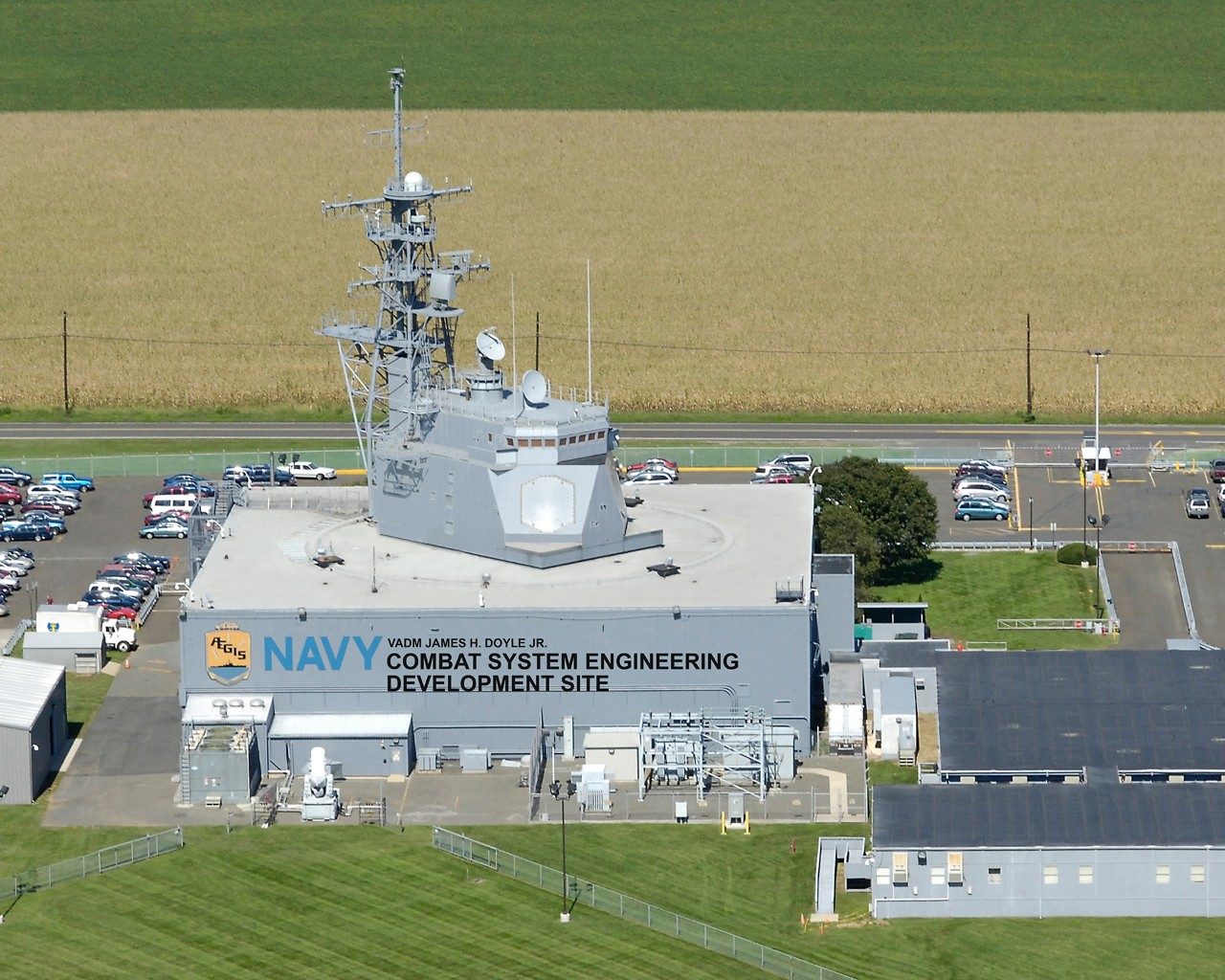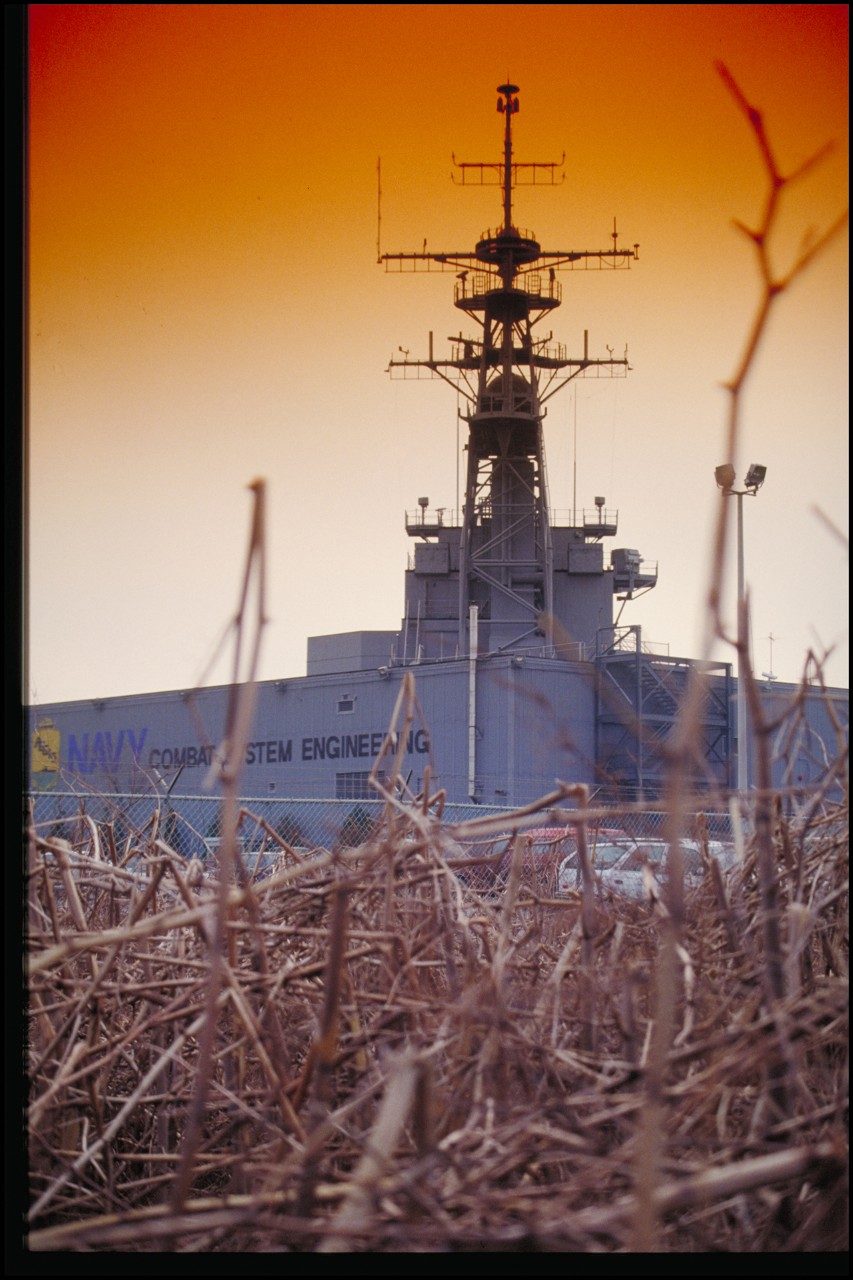In the cornfields of southern New Jersey, there rises a sight that makes passersby look twice. It even draws in curious tourists, but this is no tourist attraction.
What looks like a warship among the waving cornstalks is actually, well, a warship among the cornstalks.
Known to locals as the “Cruiser in the Cornfield”—or the USS Rancocas, for its closest body of water, Rancocas Creek—the facility is officially called the Vice Admiral James H. Doyle Combat Systems Engineering Development Site (CSEDS). Housing both Navy and Lockheed Martin personnel, the research and development facility is devoted to the AEGIS Combat System, a revolutionary naval air defense system capable of guarding against missile threats from land, sea and air.
Originally owned by the Air Force, the building was constructed in the 1950s. For years it was an Air Force-operated radar site, operating a ballistic missile early warning system. The warehouse-like gray building was topped by a radome, a large golf ball-like structure that protected its radar from volatile weather conditions. This giant golf ball was a familiar sight to travelers along I-295 until 1977, when the Air Force sought to close the site down.
That’s when Rear Admiral Wayne E. Meyer stepped in. Often called the “Father of AEGIS,” Rear Admiral Meyer believed the facility could provide an opportunity the Navy was looking for. He convinced his superiors to buy the building from the Air Force. They did, for $1.
Formally commissioned as a Navy facility in 1977, the CSEDS gained a new, even more striking feature in place of the radome: the 122-foot-high forward deckhouse of a nuclear strike class cruiser. Renamed in 2008 in honor of Vice Admiral Doyle, who first oversaw the development, construction and introduction of AEGIS-equipped cruisers and destroyers to the fleet, the facility has supported the successful fielding and maintenance of AEGIS systems on more than 100 ships for the U.S. Navy and its allies around the globe.

Looking to the Future, Remembering the Past
Despite its landlocked location, the Rancocas is a commissioned naval vessel, manned by sailors of the U.S. Navy. It holds live equipment with real combat element systems, used by naval officers and maintained by Lockheed Martin employees who work side by side. The CSEDS allows the integration of full combat systems, making sure they can be tested before they’re put to sea. Two live antennae allow the crew of the Rancocas to test the system’s capabilities by tracking commercial flights around New York City.
In 2010, ten years after the attack on the USS Cole (DDG-67) in Yemen, one of her damaged SPY-1D radar antennas found a new home at CSEDS. The Navy asked Lockheed Martin to repair and refurbish the antenna to support research and development of future AEGIS systems. The team proudly delivered ahead of schedule and nearly $1 million under budget.
While the physical appearance of CSEDS remained the same, the added capability of the full production model antenna enables CSEDS to test next-generation systems and increases the Navy’s ability to resolve shipboard issues in a controlled environment.

From a Jersey Cornfield to the Pacific Ocean
More recently, CSEDS completed an upgrade of the AEGIS system that was two years in the making. Formally tested in May 2012, the upgraded system, known as Baseline 9, successfully demonstrated simultaneous anti-air warfare and ballistic missile defense capabilities. This most recent development will allow greater mission flexibility with a processor that is scalable and easily updated.
Baseline 9 demonstrations were completed in November 2012, and the system is now in the final stages of development. It’s currently being field-tested aboard the USS Chancellorsville, in the waters near San Diego.
From a New Jersey cornfield to the waters of the Pacific, the CSEDS allows sailors to get real training on the same equipment they’ll use to protect the world’s oceans.
Sources and Further Reading
- Interview with James Sheridan, The History Factory, 4 December 2012, Washington, DC.
- Lockheed Martin. “AEGIS Combat System.”http://www.lockheedmartin.com/us/products/AEGIS.html, accessed September 11, 2012.
- Lockheed Martin. “Lockheed Martin Awarded $160 Million for Continued Support of U.S. Navy Land-based AEGIS Test Facility.” http://www.lockheedmartin.com/us/news/press-releases/2010/february/LockheedMartinAwarded160M.html, accessed August 22, 2012.
- Lockheed Martin. “Lockheed Martin’s AEGIS Combat System Showcases Integrated Air and Missile Defense Capabilities.” http://www.lockheedmartin.com/us/news/press-releases/2012/may/0516-ms2-lockheed-martins-AEGIS-combat-system-showcases-integrated-air-a.html, accessed September 6, 2012.
- Lockheed Martin. “Modified Lockheed Martin AEGIS Weapon System Successfully Destroys Errant Satellite.” http://www.lockheedmartin.com/us/news/press-releases/2008/february/MODIFIEDLOCKHEEDMARTINAEG.html, accessed August 31, 2012.
- “Moorestown, New Jersey: Cornfield Cruiser – USS Rancocas (LS-1).”http://www.roadsideamerica.com/tip/894, accessed August 24, 2012.
- Naval Sea Systems Command. “AEGIS Technical Representative.” U.S. Navy.http://www.navsea.navy.mil/AEGIStechrep.aspx, accessed August 22, 2012.
- “USA: Lockheed Martin Completes AEGIS Computer Program Development.” Naval Today.http://navaltoday.com/2012/05/22/usa-lockheed-martin-completes-AEGIS-computer-program-development/, accessed September 6, 2012.




